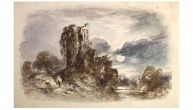
Sunday 20th June 2021 - Belle Gait

An extremely rare copy of the poem by Thomas Gray was found in a Sussex cottage.
If you haven't taken the time to have a look at the Gorringe's catalogue, you are missing out on a truly unique item. Spotted unexpectedly during a routine valuation visit was this first edition of Thomas Gray's 'Elegy Written in a Country Churchyard'. Seemingly unrecognised for its value and uniqueness, the book was found on a bookshelf in the home; now, this rare item will be sold by Gorringe's on 29 June. It has been given an impressive estimate of £100,000-150,000.
Thomas Gray was born on 26 December 1716 in Cornhill, London. He attended Eton College and was inspired by his uncle Robert Antrobus to love observational science and botany. He began writing poems more seriously following the death of his close friend Richard West. This death inspired the poem 'Sonnet of the Death of Richard West'. He spent a lot of his life working as a professor in Cambridge at Pembroke College. Struggling with impostor syndrome, Gray only published 13 poems and turned down the offered position of Poet Laureate in 1757. He sadly died in 1771.
It is believed by many writers that 'Elegy Written in a County Churchyard' was started in 1742 in Stoke Poges, Buckinghamshire, in the graveyard of St Giles parish church. Where it is said that the grave of Gray's much-loved aunt, Mary Antrobus, had acted as the catalyst for his poem, this claim is not exclusive. However, it is undeniable that it then spent many years in an unfinished state before finally being completed in 1750. Robert Dodsley subsequently published the poem in 1751. The tone, calm, reflective and stoic, led to the poetry receiving great admiration. It is even said that British General James Wolfe recited the poem to one of his officers before the Battle of the Plains of Abraham. He is claimed to have added, "I would prefer being the author of that poem to the glory of beating the French to-morrow."
This particular copy has been edited and has an introduction by John Martin. Published by Jon Van Voorst in 1836 (and most likely funded by Samuel Rogers), this first illustrated edition of the great poem is a significant rarity. This quarto copy has 17 original watercolours and drawings. Each one is bound in immediately before the stanza to which it relates. The illustrated version featured 33 wood engravings. These illustrations aimed to capture the vivid imagery of the poetry and explore themes in the text such as mortality, legacy and remembrance.
These works of art include three watercolours by John Constable and other pieces by artists such as Peter De Wint, Charles Landseer and Richard Westall. The influential artists were commissioned by the illustrious Regency bookseller, bibliographer and librarian.
The particular version of the illustrated poem was John Martin's personal copy. It is believed that the book was handed down through the seller's family; however, they are not clear as to how they originally came to acquire it.
In addition to the 'Elegy', two hand-written letters were found within the Morroco red gilt cover. one of these letters from Constable to Martin is dated 1835. Contained in the letter is a sketch of the church in Stoke Poges, Buckinghamshire. The other letter, dated two years later, is from Rogers to Martin.
This incredible item will go for sale on 29 June at Gorringe's – you can bid live here.